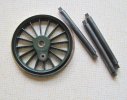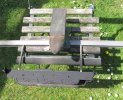Haha - as long it's a Gallic shrug...
The problem with colour is it's so subjective and the descriptions are based on what the viewer saw/perceived in the lighting conditions at the time.
Even more difficult with pre-grouping colours as there's no-one around today who can remember. The closest we are likely to get is from early preserved steam locos such as Gladstone and including those by preserved by British Rail in the 1950's and 60s which would have been repainted in their workshops by people (albeit elderly) who had worked on the railways from the pre-grouping days. Later colour matching would be to those samples.
At the end of the day I'd go with what looks right to your eyes.
I'm afraid I'm one of those modellers who looks a several colour photos (and colour plates for pre-group) knowing there will be a tolerance for processing and computer imaging and just make it up from there. Since most of my locos and rolling stock is weathered no-one will know. On the other hand it sure fire gets the pedants going - much to my amusement

.
There’s no-one around who can remember. True, but the models made at the time still exist, at least many of them do. I am always surprised that this contemporary record of liveries is widely ignored, including by modellers. I would suggest it’s amongst the best information available.
Some questions, of course. Was the colour on the model right in the first place? For good quality contemporary models such as those by Bing for Bassett-Lowke, I would trust the manufacturer to have generally got the colour correct. There will have been mistakes, for sure, as there are in some modern models. But getting a paint sample from the railway company to match is likely to have been easy, and the railway companies were generally only to happy to have models of their trains sold to potential travellers. Getting the colour wrong would surely affect sales of the model, so there was every incentive to get it right.
Has the colour of the paint changed over time? Possibly, faded for example if the model has been left in sunlight. But it is usually obvious if there has been significant fading. What about the effect of varnish? This can have a dramatic effect as it will have darkened and yellowed over time. But look underneath the model. There is every chance of finding some paint that did not get varnished, probably hasn’t faded either — so is very likely the authentic colour.
I bought the Caledonian liveries book. A huge and lengthy discussion of what colour blue was used. Contemporary exhibition models are referred to, but not the regular models made by Bing, Leeds Model Company (LMC) etc. When I needed ‘Caledonian Blue’ for repainting a model I chose a colour matched to paint on the underside of a Bing model and an LMC model, both made in 1921/22 and both the same shade. My loco is a much darker blue than is often applied to modern models. (Models made in 1921/22 will have copied the paler blue used after 1906, but it’s still not ‘pale blue’).
I don’t believe there was a contemporary commercial model wearing the livery for the loco in this thread. But the principle I think is sound. Look to the models of the day for livery guidance. Some of them will be in paint supplied by the full-size railway company, or from the same supplier as was used by the full-size railway company. It doesn’t get more authentic than that.
.



 .
.